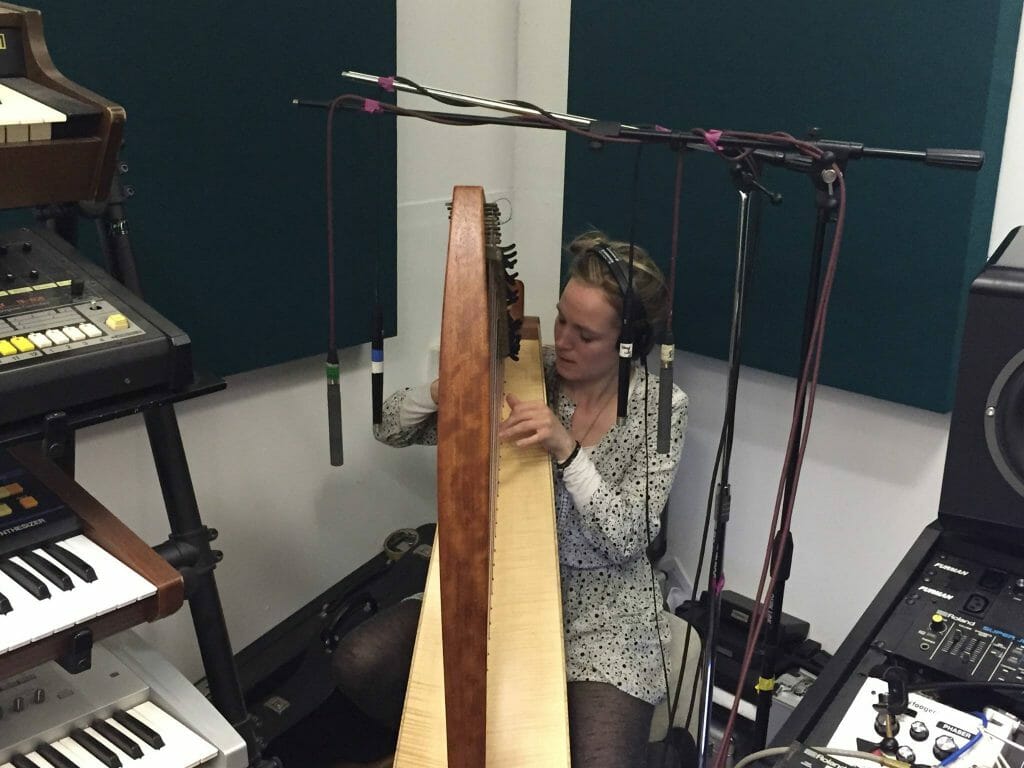Last weekend Gianluca Capacchione and I were working with Hattie Webb . We recorded a very special song for Hattie’s upcoming album. Hattie’s brother Brad Webb joined us also to play some fantastic percussion parts and he also provided the backing vocals for this song. Wow, what an amazingly talented family these kids come from…
I love the sound of Hattie’s harp. Whatever we may decide to do with the harp sound during mixdown, I want to capture the glorious timbre of this instrument in the most natural and realistic way. In this particular instance I don’t want the recording method that we use to colour the sound and change the timbre of the harp. This is why I decided to record the harp with pressure operated omni directional microphones. These microphones are typically the best at capturing sound in the most truthful way. I want the microphones to be close to the instrument in order to register all the beautiful sonic detail. Getting close to the sound source with any directional microphone causes the lower frequencies to be reproduced with a relatively higher amplitude. This is called the proximity effect. Sometimes the proximity effect can be used to your advantage, especially when you want the recording to sound bigger, darker and more powerful than the real thing.
That’s not what I’m interested in today: I simply want to register the sound of Hattie’s harp the way it is. Pressure operated microphones do not exhibit the proximity effect and therefore they reproduce the sound in a much more realistic way. As with all great musicians, the way that Hattie controls her instrument is based upon the way that she actually hears it as she is playing. This is why I want to capture the sound from Hattie’s acoustical perspective. Having microphones not too far from Hattie’s head ensures that I capture the sound of the instrument the way she intended it to be. Of course I also want the sound of the harp to be in beautiful stereo. This is why I decided to use a spaced pair of microphones, one either side of the strings.
As with all other string instruments, the strings of the harp produce very little sound by themselves. Their vibrations are passed on to the soundboard, which has the job of passing on the sound vibrations onto the air. Both microphones are positioned inside the main wave front that is created by the soundboard of the harp. Different frequencies are registered at slightly different points in time by these 2 microphones. It is these small time arrival differences that create a subtle and realistic stereo spread when both microphones are panned hard left and right in the mix.
DPA vs Shoeps.
Coming up with a recording strategy like this comes relatively easy to me. What I find not so easy is to predict is which model of pressure operated microphone will actually sound best! Sometimes you simply don’t know until you try. I have 2 pairs of pressure operated microphones in my arsenal. First of all there is my trusted pair of Brüel & Kjær (DPA) 4003’s. I have used them as room mics on many Tori Amos recordings and I love them very much. These microphones are unusual because they operate on 130V instead of the usual 48V phantom power. These mics have a very linear frequency response and an extremely low noise floor. My other option is to use s pair of Shoeps CMC6 Ug’s with MK2 capsules. I bought these superb microphones more recently and I have to say that I’m extremely impressed by them. I’ve used them as close mics on several different acoustic instruments and the results have always been fantastic. The DPA’s have their own extremely high quality microphone pre-amplifier (DPA HMA-4000). For the Shoeps I’m using my trusted Chandler TG-2. Both stereo pairs are state of the art. Listening to the recording I can tell that both sets of microphones are extremely high quality, but there is is certainly a slight difference in sonic character between the 2 pairs.
Which pair will we end up using in the mix? I think I will let Hattie decide which pair she prefers. After all she knows the sound of her harp better than anyone else!
Ciao, Marcelx
PS – Hattie is running a PledgeMusic campaign to fund rcording of the album that Marcel is describing! Please support if you can. I did! (DDLS)
